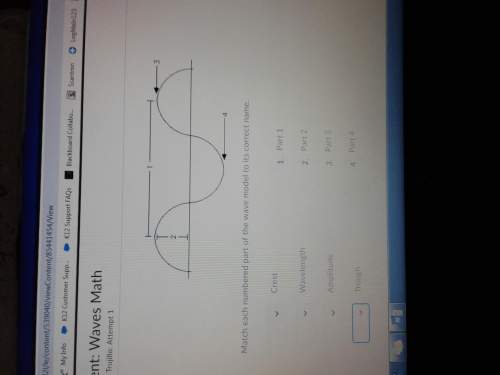
These models show the electron structures of two different nonmetal elements. which element is likely more reactive, and why? element 1 is more reactive because it has fewer electron shells and is toward the top of its group on the periodic table. element 1 is more reactive because it has more electrons in its valence shell and is farther to the right on the periodic table. element 2 is more reactive because it does not have a valence shell close to the nucleus, so it will attract electrons. element 2 is more reactive because it does not have a full valence shell, so it will attract electrons.

Answers: 1


Another question on Physics

Physics, 21.06.2019 22:00
There is a theory that indicates that dinosaurs became extinct when about 65 million years ago, a large asteroid hit the earth surface. dust caused by this collision blocked the sunlight reaching the earth's surface and many forms of life became extinct due to the cold. fearing this threat, how large the radius of an asteroid should you be looking for if the dangerous asteroid size is approximately the same as the one that killed the dinosaurs? available data suggests that about 18% of that asteroid's mass ended up as a dust spread evenly over earth after eventually settling out of the upper atmosphere. about 0.0180 g/cm^2 of dust, which is chemically different than the earth's rock, covered the earth's surface. typical asteroids have a density of about 1.9 g/cm^3. now that we know the size of the asteroid, how much energy was released during impact, assuming all of it was just the kinetic energy of the asteroid right before the impact?
Answers: 1

Physics, 22.06.2019 13:10
Aplane flying horizontally at an altitude of 1 mile and a speed of of 500mih passes directly over a radar station. find the rate at which the distance from the plane to the station is increasing when it is 2mi away from the station.
Answers: 1

Physics, 22.06.2019 18:30
Daughter element the new element produced along with a decay particle in a nuclear transmutation 2. half-life the substance that decays in a nuclear transmutation 3. parent element the change of one chemical element into another by nuclear decay or radioactive bombardment 4. transmutation the time required for the decay of one-half of the atoms in a sample of radioactive material
Answers: 2

Physics, 22.06.2019 20:50
An ideal otto cycle has a compression ratio of 8. at the beginning of the compression process, air is at 95 kpa and 27°c, and 750 kj/kg of heat is transferred to air during the constant-volume heat-addition process. assuming constant specific heats at room temperature, determine (a) the pressure and temperature at the end of the heat-addition process, (b) the net work output, (c) the thermal efficiency, and (d) the mean effective pressure for the cycle. (4390 kpa, 1730 k; 423 kj/kg; 56.4%; 534 kpa)
Answers: 1
You know the right answer?
These models show the electron structures of two different nonmetal elements. which element is likel...
Questions

Mathematics, 10.03.2021 21:30

Mathematics, 10.03.2021 21:30

English, 10.03.2021 21:30



Mathematics, 10.03.2021 21:30


Health, 10.03.2021 21:30

Social Studies, 10.03.2021 21:30

Mathematics, 10.03.2021 21:30

Health, 10.03.2021 21:30

History, 10.03.2021 21:30



Mathematics, 10.03.2021 21:30

Chemistry, 10.03.2021 21:30

Mathematics, 10.03.2021 21:30


Geography, 10.03.2021 21:30





